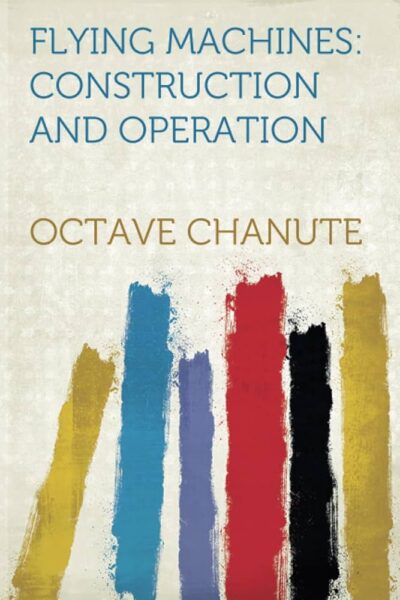54 Results in the "Non-Fiction" category
Biography & Memoir (434)
Books Like (8)
Business & Finance (26)
Children’s Fiction (203)
Dystopian (16)
Education & Learning (9)
Fantasy (1214)
fashion (1)
Fiction (4477)
Health & Wellness (21)
Historical Fiction (504)
Horror (159)
Literary Fiction (788)
Novel (229)
Others (106)
Philosophy (128)
Poetry (208)
Politics & History (131)
Posts (65)
Psychology (46)
Religion & Spirituality (1)
Romance Novel (535)
Science & Technology (82)
Science Fiction (220)
Self-Help & Personal Development (99)
Thriller / Mystery (858)
Travel & Adventure (2)
True Crime (55)
view (96)
Young Adult (284)
-
 Chapter XXIV - Flying Machines Construction And Operation turns its focus toward one of the most essential components in early aviation: the propeller. This chapter breaks down the complexity behind what might seem like a simple rotating blade, revealing how subtle variations in shape, pitch, and alignment can drastically impact a flying machine’s performance. Every designer works with the same basic goal—to generate maximum thrust with minimal energy—yet each brings personal techniques to the…
Chapter XXIV - Flying Machines Construction And Operation turns its focus toward one of the most essential components in early aviation: the propeller. This chapter breaks down the complexity behind what might seem like a simple rotating blade, revealing how subtle variations in shape, pitch, and alignment can drastically impact a flying machine’s performance. Every designer works with the same basic goal—to generate maximum thrust with minimal energy—yet each brings personal techniques to the…-
142.7 K • Ongoing
-
-
 Chapter XXV-Flying Machines Construction And Operation reflects a pivotal moment in aviation where advancements in engine technology significantly reshaped aircraft design. In the time since this book's initial release in 1910, rapid progress in motor development allowed for aircraft to operate with far smaller wing surfaces than before. This shift stemmed from both a drop in engine weight and an increase in engine power, enabling planes to achieve higher speeds while requiring less lift-generating area.…
Chapter XXV-Flying Machines Construction And Operation reflects a pivotal moment in aviation where advancements in engine technology significantly reshaped aircraft design. In the time since this book's initial release in 1910, rapid progress in motor development allowed for aircraft to operate with far smaller wing surfaces than before. This shift stemmed from both a drop in engine weight and an increase in engine power, enabling planes to achieve higher speeds while requiring less lift-generating area.…-
142.7 K • Ongoing
-
-
 Chapter XXVI-Flying Machines Construction And Operation offers a focused look into the evolution of early aviation, particularly the gradual but notable shift in American aircraft design. While biplanes had dominated the scene for years, interest in monoplanes began to rise, especially following the success of Curtiss and others at the 1910 International meet at Belmont Park. Though American entries in the monoplane class were limited, Curtiss's own single-wing creation drew considerable attention. His…
Chapter XXVI-Flying Machines Construction And Operation offers a focused look into the evolution of early aviation, particularly the gradual but notable shift in American aircraft design. While biplanes had dominated the scene for years, interest in monoplanes began to rise, especially following the success of Curtiss and others at the 1910 International meet at Belmont Park. Though American entries in the monoplane class were limited, Curtiss's own single-wing creation drew considerable attention. His…-
142.7 K • Ongoing
-
-
 Chapter V - Flying Machines Construction And Operation walks readers through the foundational process of designing and constructing a practical gliding machine. It introduces essential structural choices and suggests starting with a biplane layout, given its balance between simplicity and performance. With a manageable frame and ample surface area, the biplane helps beginners grasp core aerodynamics without being overwhelmed by complexity. A biplane glider is effective because it divides the necessary lift…
Chapter V - Flying Machines Construction And Operation walks readers through the foundational process of designing and constructing a practical gliding machine. It introduces essential structural choices and suggests starting with a biplane layout, given its balance between simplicity and performance. With a manageable frame and ample surface area, the biplane helps beginners grasp core aerodynamics without being overwhelmed by complexity. A biplane glider is effective because it divides the necessary lift…-
142.7 K • Ongoing
-
-
 Chapter VI - Flying Machines Construction And Operation lays the groundwork for anyone beginning their journey into aviation by focusing on the balance between enthusiasm and caution. Instead of jumping into dramatic heights, the text promotes a measured approach where pilots learn close to the ground. This method ensures safety and builds a strong sense of control before attempting more ambitious flights. Learning to fly begins with understanding wind behavior and how body movement affects the glider’s…
Chapter VI - Flying Machines Construction And Operation lays the groundwork for anyone beginning their journey into aviation by focusing on the balance between enthusiasm and caution. Instead of jumping into dramatic heights, the text promotes a measured approach where pilots learn close to the ground. This method ensures safety and builds a strong sense of control before attempting more ambitious flights. Learning to fly begins with understanding wind behavior and how body movement affects the glider’s…-
142.7 K • Ongoing
-
-
 Chapter I - Flying Machines Construction And Operation begins with a detailed account of how the concept of multi-surface flight evolved, laying the groundwork for future breakthroughs in aviation. Octave Chanute opens the discussion by recognizing the early insight of F. H. Wenham, who, in 1866, proposed stacking aeroplanes vertically to expand lift area without excessive weight. His design incorporated silk or canvas stretched over a framework and supported the idea of using multiple wings to lift a…
Chapter I - Flying Machines Construction And Operation begins with a detailed account of how the concept of multi-surface flight evolved, laying the groundwork for future breakthroughs in aviation. Octave Chanute opens the discussion by recognizing the early insight of F. H. Wenham, who, in 1866, proposed stacking aeroplanes vertically to expand lift area without excessive weight. His design incorporated silk or canvas stretched over a framework and supported the idea of using multiple wings to lift a…-
142.7 K • Ongoing
-
-
 Chapter II - Flying Machines Construction And Operation explores the early stages of aviation by contrasting two major categories of flight—lighter-than-air balloons and heavier-than-air flying machines. Unlike balloons that drift by gas-based lift, true flying machines rely on forward propulsion and airfoil lift, drawing their core principle from birds. The fascination with avian motion inspired early pioneers to imitate nature's balance between wing surface and body weight through mechanical means. Key…
Chapter II - Flying Machines Construction And Operation explores the early stages of aviation by contrasting two major categories of flight—lighter-than-air balloons and heavier-than-air flying machines. Unlike balloons that drift by gas-based lift, true flying machines rely on forward propulsion and airfoil lift, drawing their core principle from birds. The fascination with avian motion inspired early pioneers to imitate nature's balance between wing surface and body weight through mechanical means. Key…-
142.7 K • Ongoing
-
-
 Chapter III - Flying Machines Construction And Operation explores the basic aerodynamic principles that allow both birds and aircraft to achieve and sustain flight. Through simple, observable experiments, it reveals how motion and air interaction contribute to lift. These foundational insights form the basis of understanding why flying machines behave as they do once airborne. A common demonstration uses a flat circular piece of cardboard. When dropped, gravity pulls it down immediately. But when it’s…
Chapter III - Flying Machines Construction And Operation explores the basic aerodynamic principles that allow both birds and aircraft to achieve and sustain flight. Through simple, observable experiments, it reveals how motion and air interaction contribute to lift. These foundational insights form the basis of understanding why flying machines behave as they do once airborne. A common demonstration uses a flat circular piece of cardboard. When dropped, gravity pulls it down immediately. But when it’s…-
142.7 K • Ongoing
-
-
 Chapter IV - Flying Machines Construction And Operation presents a clear comparison of the three principal types of manned flying machines: aeroplanes, helicopters, and ornithopters. Each model approaches flight through a distinct mechanism, but not all methods yield practical or efficient results. Among them, the aeroplane rises as the most successful, both in design application and operational reliability. Helicopters are recognized for their ability to ascend vertically using rotating blades, allowing…
Chapter IV - Flying Machines Construction And Operation presents a clear comparison of the three principal types of manned flying machines: aeroplanes, helicopters, and ornithopters. Each model approaches flight through a distinct mechanism, but not all methods yield practical or efficient results. Among them, the aeroplane rises as the most successful, both in design application and operational reliability. Helicopters are recognized for their ability to ascend vertically using rotating blades, allowing…-
142.7 K • Ongoing
-
-
Chapter
Preface
 Preface introduces the life and spirit of Saint Stanislaus Kostka not with dry reverence, but with energetic admiration. William T. Kane speaks not only to theologians or scholars but to anyone willing to consider that sanctity can take root even in the heart of youth. Unlike those who see holiness as the slow work of old age and suffering, Kane boldly defends the idea that a teenager—filled with life, energy, and clarity of purpose—can reach extraordinary spiritual heights. He acknowledges the rarity…
Preface introduces the life and spirit of Saint Stanislaus Kostka not with dry reverence, but with energetic admiration. William T. Kane speaks not only to theologians or scholars but to anyone willing to consider that sanctity can take root even in the heart of youth. Unlike those who see holiness as the slow work of old age and suffering, Kane boldly defends the idea that a teenager—filled with life, energy, and clarity of purpose—can reach extraordinary spiritual heights. He acknowledges the rarity…-
69.5 K • Ongoing
-
- Previous 1 … 17 18 19 … 31 Next
